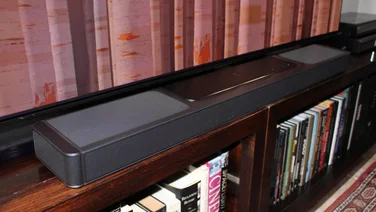To help us provide you with free impartial advice, we may earn a commission if you buy through links on our site. Learn more


Benq’s W1000+ is an improved version of the W1000 that we reviewed last year. It looks the same on the outside, but it’s had a full hardware revamp, with higher contrast, longer lamp life, plus a faster colour wheel.

Like its predecessor, it’s a compact and quiet DLP projector with an unobtrusive design and a 1080p resolution. It has composite, component, S-video and two HDMI inputs. Its slim white chassis won’t take over a room, whether you ceiling mount it or place it on a shelf. It doesn’t have a lens cap, although its recessed lens should help protect it from dust and scratches. An integrated speaker comes on every time you start the projector, but this easily muted by a button on the remote control. The remote is a little cluttered, but lights up when used and all the buttons are clearly labelled.
The projector has three pre-set modes and three extra user-definable modes. The presets are Cinema, which has intense colours, and is best suited to watching a film in a darkened room; Dynamic, which looks a little cold but ramps up the brightness to ensure that the projected image is clear and vivid with the lights on, and Standard, which is a compromise between the two that looks okay with the lights on but works best in darkness.
Each of these can be used as a reference from which you can fine-tune settings to create your own preset. As well as the usual brightness, contrast and colour intensity settings, you can also adjust the colour tint, and make subtle saturation adjustments to make flesh tones as realistic as possible. This flexibility is great, but the default settings are more than adequate for most people.
Even more settings are available in the Picture: Advanced menu, where you can adjust the gamma and enable and disable Brilliant Colour mode, which produces more vivid, but less natural colours. Even more fine adjustment is available in sub-menus, like Clarity Control, where you can reduce noise and enhance detail, and the slight confusing 3D Colour Management menu, which allows you to adjust the intensity of red, green or blue tones.

Although its hardware has been improved, this is still a colour-wheel DLP projector, so the infamous rainbow effect is inevitable. It mostly shows up in black and white video footage, as well as in some high-contrast scenes. However, it’s surprisingly unobtrusive. Images in Cinema mode were a little over-saturated but pleasing on the eye.
We were pleased to find that although motion blur was conspicuous in our most demanding moving image test, in which a playing card zips around the display, it didn’t have much impact in our real-world tests. For example, a fast-paced football match only showed a little blur during fast ball movement and diving saves. We also appreciated the projector’s rich black tones and excellent contrast.
With its bright 2,000 lumens lamp, this projector is a good choice if you want a projector you can use in lit rooms. If it’s pure cinema you’re after, the Samsung SP-A600B has better image quality and is the better choice.





